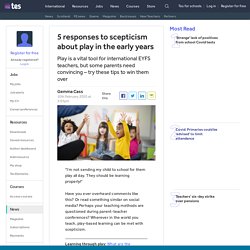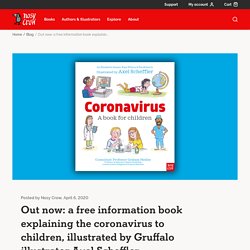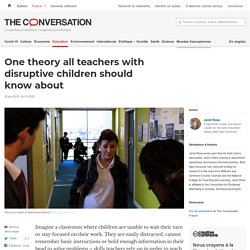

Week 6. Primary Plus – English for kids aged 6-12. During the Covid-19 pandemic many of our teaching centres are closed. Classes will continue online and our teachers look forward to bringing their passion and expertise into your home. Primary Plus, developed by our team of English experts, will spark your child’s imagination, so they can express themselves with confidence that goes beyond their English language skills.
Our new approach means your child will have a more rewarding learning experience, getting the most out of learning English at home with a combination of: live online classes with a specialist teacherinteractive independent study, set by your child's teacher to prepare them for the live lesson – all in a safe, easy-to-use learning environment.
You will have access to your child’s personal dashboard. Low-cost play ideas & materials. 5 ways to win over parents to the importance of play in international EYFS. "I’m not sending my child to school for them play all day.

They should be learning properly! " Have you ever overheard comments like this? Or read something similar on social media? Perhaps your teaching methods are questioned during parent-teacher conferences? Microsoft Word - Useful comments and conversations April-May_2020.docx - Useful_comments_and_conversations_April-May_2020.pdf. Early Learning for Every Child Today. A framework for Ontario early childhood settings - continuum.pdf. Assessment for learning. Early Learning for Every Child Today. A framework for Ontario early childhood settings - continuum.pdf. Microsoft Word - Information sheet - Documentation updated 26 May 2014 copy.docx - Information_sheet_-_Guidelines_for_documenting_children_s_learning.pdf.
Pre-birth to Three: Observation, Assessment and Planning. Let’s lose the ADHD label and find the child. When I trained as a primary school teacher 15 years ago, these were some of the words used to describe children with ADHD: ‘Difficult.’

‘Challenging.’ ‘Disruptive.’ There were others, whispered by harassed-looking teachers in the staffroom or concerned parents at the school gates, but none seemed to be positive. When I got my first ‘real’ class to teach, and saw that some of the children came with the dreaded ‘ADHD’ label attached, I approached the new term with butterflies the size of dragons in my stomach.
But here’s what it took me a few more years to learn… Development-Matters-FINAL-PRINT-AMENDED.pdf. Week 5 - Safety & Happiness. The Power of Positive Adult-Child Relationships: Connection is the Key - the_power_of_positive_relationships.pdf. Out now: a free information book explaining the coronavirus to children, illustrated by Gruffalo illustrator Axel Scheffler - Nosy Crow. Axel Scheffler has illustrated a digital book for primary school age children, free for anyone to read on screen or print out, about the coronavirus and the measures taken to control it.

Published by Nosy Crow, and written by staff within the company, the book has had expert input: Professor Graham Medley of the London School of Hygiene & Tropical Medicine acted as a consultant, and the company also had advice from two head teachers and a child psychologist. The book answers key questions in simple language appropriate for 5 to 9 year olds:
2Bbellybreathhome. This ‘Kindness Curriculum’ Is Free And Should Be Used In Every Classroom. Imagine living in a world that valued kindness enough to teach it along with academics. Educators would teach kids to manage their emotions in addition to standard curriculum such as math and science. Sounds pretty amazing, doesn’t it? Well, the Center for Healthy Minds at the University of Wisconsin-Madison has created a free “kindness curriculum” for kids, designed to do just that. It’s a mindfulness-based curriculum for preschoolers that will bring kindness into the classroom. “Faced with mental and physical health challenges at a global scale, we conduct rigorous scientific research to bring new insights and tools aimed at improving the wellbeing of people of all backgrounds and ages,” states the Center’s mission statement.
The Key to Effective Classroom Management. It’s a daunting but all-too-common sight for many teachers: A classroom full of rowdy students who are unable to focus on the lesson. Classroom management techniques may get things back on track, but valuable time has already been lost. Many experienced teachers know that making meaningful connections with students is one of the most effective ways to prevent disruptions in the first place, and a new study set out to assess this approach. In classrooms where teachers used a series of techniques centered around establishing, maintaining, and restoring relationships, academic engagement increased by 33 percent and disruptive behavior decreased by 75 percent—making the time students spent in the classroom more worthwhile and productive.
“Strong teacher-student relationships have long been considered a foundational aspect of a positive school experience,” explains Clayton Cook, the lead author of the study and a professor at the University of Minnesota. A 19-Year Study Reveals Kindergarten Students With These 2 Skills Are Twice as Likely to Obtain a College Degree (and They Have Nothing to Do With Reading) One theory all teachers with disruptive children should know about.
Imagine a classroom where children are unable to wait their turn or stay focused on their work.

They are easily distracted, cannot remember basic instructions or hold enough information in their head to solve problems – skills teachers rely on in order to teach successfully. These behavioural issues are all examples of problems that can arise from attachment issues – based on the relationship between children and their main caregiver. Attachment theory is now one of the world’s most well-researched theories about human development. Don't Expect Toddlers To Behave Consistently — They Literally Can't.
One day, when my oldest daughter was not quite 2, she wouldn’t sit still to let me change her diaper. Squirrelly and writhing, she made a game out of staying half naked. She wasn’t fussing about it or anything — in fact, she was giggling maniacally. The problem was that we were running late. Can Free Play Prevent Depression and Anxiety In Kids? Which Early Childhood Experiences Shape Adult Life? Why Empathy Holds the Key to Transforming 21st Century Learning. HowLearningHappens. Key Person & Attachment - Early Years Matters. The Key Person Children thrive from a base of loving and secure relationships. This is normally provided by a child’s parents but it can also be provided by a key person. A key person is a named member of staff with responsibilities for a small group of children who helps those children in the group feel safe and cared for.
The role is an important one and an approach set out in the EYFS which is working successfully in settings and in Reception classes. It involves the key person in responding sensitively to children’s feelings and behaviours and meeting emotional needs by giving reassurance, such as when they are new to a setting or class, and supporting the child’s well-being. How Are Happiness and Learning Connected? As teachers, we also know that when students' affective filters or defenses are sky high, fight or flight responses will be modus operandi.
A room full of defensive behaviors (withdrawn, angry) is a sad, unproductive place to teach and learn. Now let's flip it and take a look at how much more we are able to learn when we are in harmony with the people and things in any given educational environment. Being in harmony means feeling safe, feeling valued and a necessary part a group, and in this case, a learning community. Guiding Principles for Use of Technology with Early Learners. The thoughtful use of technology by parents and early educators can engage children in key skills such as play, self-expression, and computational thinking which will support later success across all academic disciplines and help maintain young children’s natural curiosity.
The Departments recognize that families and early educators have many different options for using technology with early learners. The Departments believe that guidance needs to reflect the reality that families and early educators have access to apps, digital books, games, video chatting software, and a multitude of other interactive technologies that can be used with young children. Even as new technologies emerge, the Departments believe that these principles apply, though guidance may evolve as more research on this topic is published. Week 4 - CONTEXT - Whole Child Development.
What to consider when teaching English in large classes. How many students do you teach? Do you feel that your classes are too big? Author and education consultant Jason Anderson looks at the issues and offers some potential solutions. For many of us, our classes are larger than we would like them to be. They can present a number of challenges that teachers of smaller classes are less likely to face. But what exactly do we mean by large classes? Whole Child Development Is Undervalued.
The question is how to make such an approach both systemic and sustainable. Whole Person Socio-emotional, physical, creative, and cognitive capacities are deeply intertwined and equally important in ensuring a child's wellbeing, learning, and growth. (That shouldn't be a surprise to anyone studying or supporting children's learning.) Nobel laureate James Heckman, a professor of economics at the University of Chicago, has shown that the non-cognitive skills emerging in early childhood are among the strongest predictors of adult outcomes. And Paul Tough, author of How Children Succeed, has continued to emphasize the crucial role that soft skills play in character formation and building on persistence, curiosity, and even grit -- the "passion and perseverance for very long-term goals," according to psychologist Angela Lee Duckworth.
Nursery Rhymes and Songs - BBC Teach. Music and Movement Activities for Toddlers and Preschoolers. 50+ Quick & Easy Kids Crafts that ANYONE Can Make! These 50+ quick and easy kids crafts can be made in under 30 minutes using items that you probably already have around the house!
No special tools or skills are required, so ANYONE can make these cute crafts for kids! Great fun for the entire family! 50+ Quick & Easy Kids Crafts. Songs for kids. How to teach children English using illustrated storybooks. What makes illustrated storybooks such a good resource for teaching young learners of English? The British Council’s Gail Ellis, co-author of a storytelling handbook for primary English language teachers, explains. Listen to an interview with Gail in our podcast and register for her webinar taking place on Thursday, 2 October. Illustrated storybooks provide an ideal resource for helping children learn English. This is because children love listening to stories.
Storybooks present language in familiar and memorable contexts, and high quality illustrations help children understand as they match what they hear to what they see. Factsheet 2: Physical Activity Guidelines for Early Years - children-under-5-walking.pdf. Factsheet 1: Physical activity guidelines for early years - children-under-5-years.pdf. Ten ways to support your child’s English-learning at home. Practical tips. Nihms175063.pdf. Mark Making Matters: Young children making meaning in all areas of learning and development - ey_making_mark_matters76708_1_.pdf. The Art of Control.
Sound Words: Examples of Onomatopoeia. Week 3 - Labeling. How can parents and teachers best educate young children? Carol Dweck: The power of believing that you can improve. The Brain-Changing Power of Conversation. MIT Brain Study: Back-And-Forth Talk Key To Developing Kids' Verbal Skills.
Quality Interactions Early Years. Effective Teacher-Child Interactions. Serve and Return. The Power of Positive Adult-Child Relationships: Connection is the Key - the_power_of_positive_relationships.pdf.
PowerfulInteractions.pdf. Talking with Babies and Toddlers - Talking_with_Babies_and_Toddlers_June05.pdf. Effective_ways_to_help_children_s_early_language_development_POSTER.pdf. Teaching English to learners with Special Educational Needs (SENs) – Myths and realities. A longitudinal investigation of the role of quantity and quality of child-directed speech in vocabulary development. Neurodiversity TfS online conference. The Power (and Peril) of Praising Your Kids. 2Bbellybreathhome. NQS_PLP_E-Newsletter_No43.pdf. B480 Special Need Publication A4 V5 Final MR.
Listening Skills for Staff. Week 2 - Play. Schemas in Children’s Play - N a t u r e P l a y. "I Said I Want the Red Bowl!" Responding to… Does my toddler have a short attention span because she won’t sit still for a story?
Our play resources. Taking Playtime Seriously. David whitebread importance of play report. Importance of play for babies & children. How young children learn English through play. ZERO TO THREE. 6 Types of Play: How Children's Play Becomes More Social. Symbolic play and language development. Scientists Say Child's Play Helps Build A Better Brain : NPR Ed : NPR. The cognitive benefits of play: Effects on the learning brain.
Low-cost play ideas & materials. Primary school shake-up to focus on ‘play-led’ learning. Why Movement is Essential in Early Childhood. Play to Learn: Discussion. Play to Learn.
Getting the right balance between adult-led and child-initiated learning. Different types of play tip sheet - different-types-play.pdf. Week 1. Ideas, tips and resources for primary language teachers.
Deb Roy: The birth of a word. Listen to Your Mother. Let's Talk. Why does my toddler love repetition? How can I help my child to start talking? (Video) Multilingual Preschoolers. Does being bilingual make you smarter? A few more myths about speakers of multiple languages.
What Parents Can Gain From Learning the Science of Talking to Kids. Patricia Kuhl: The linguistic genius of babies. Alison Gopnik: What do babies think? Tips on Learning to Talk.